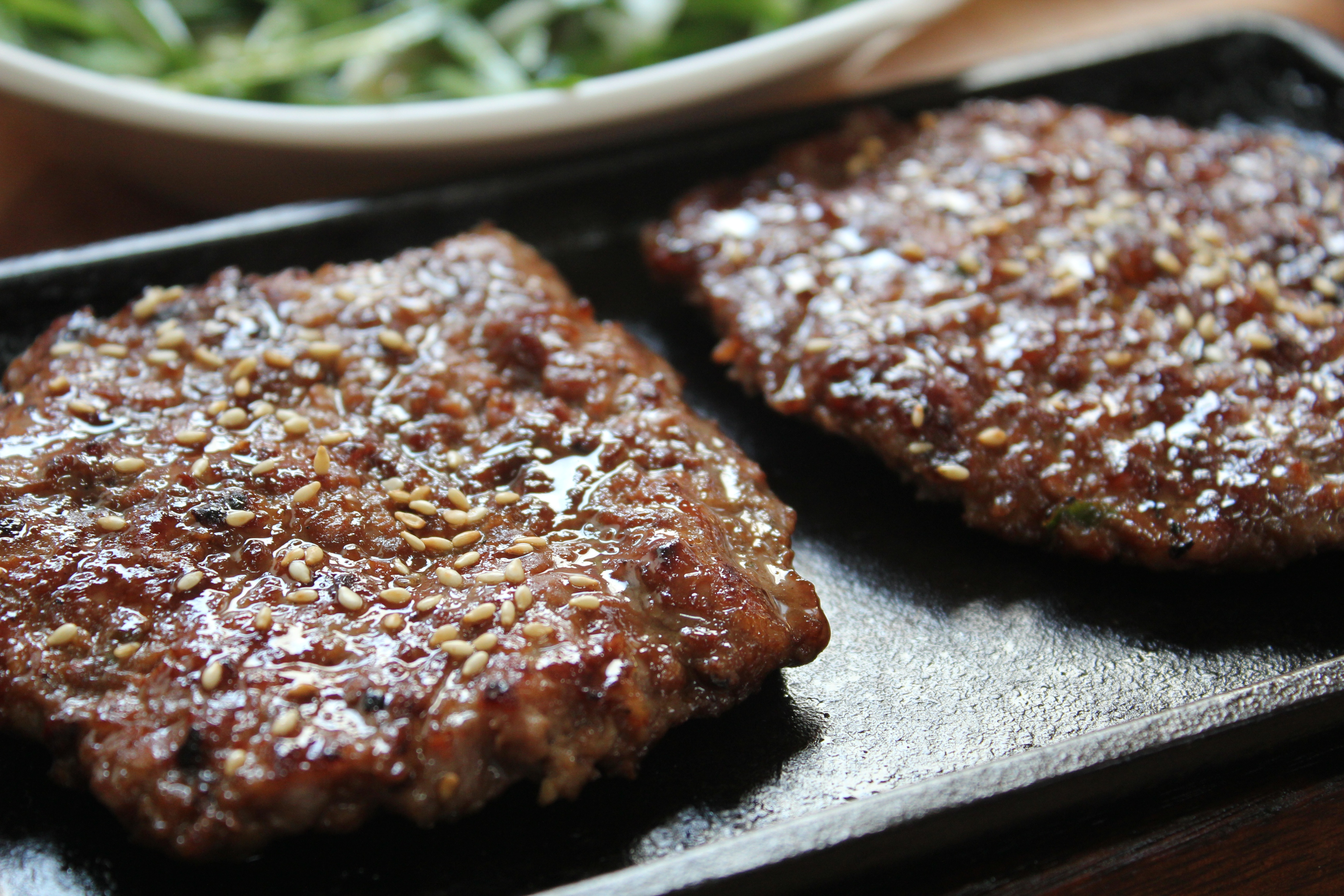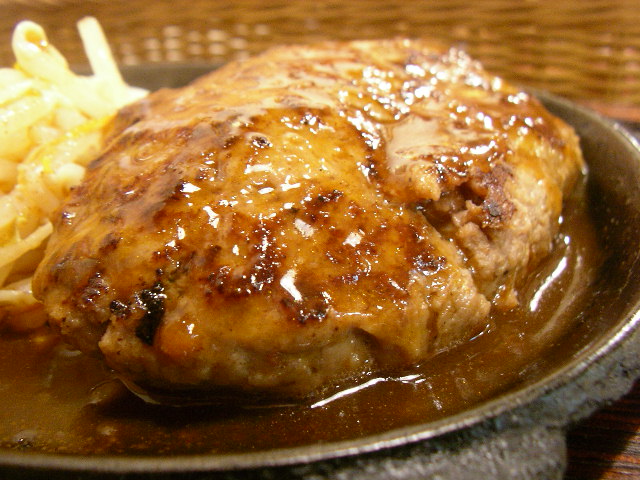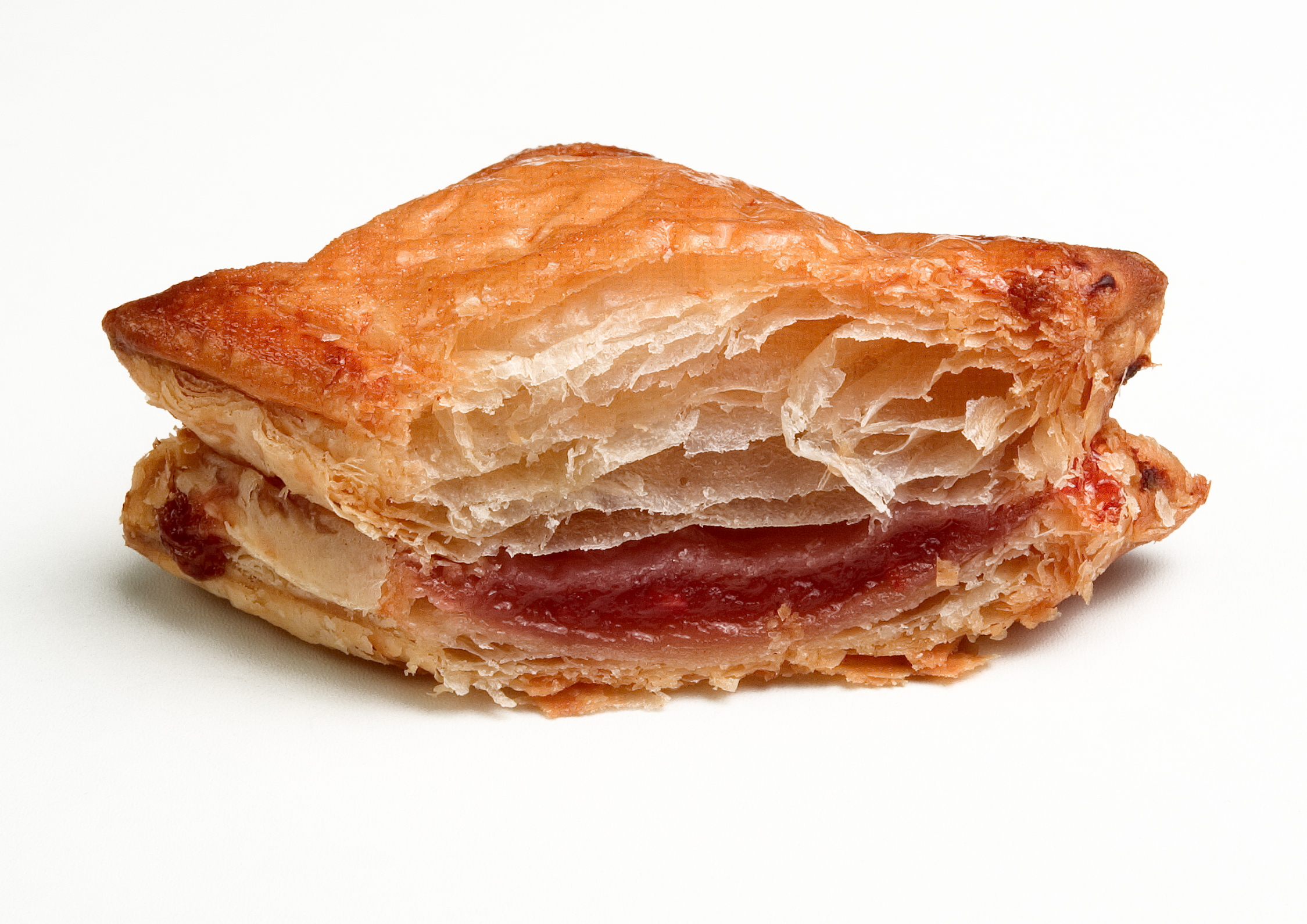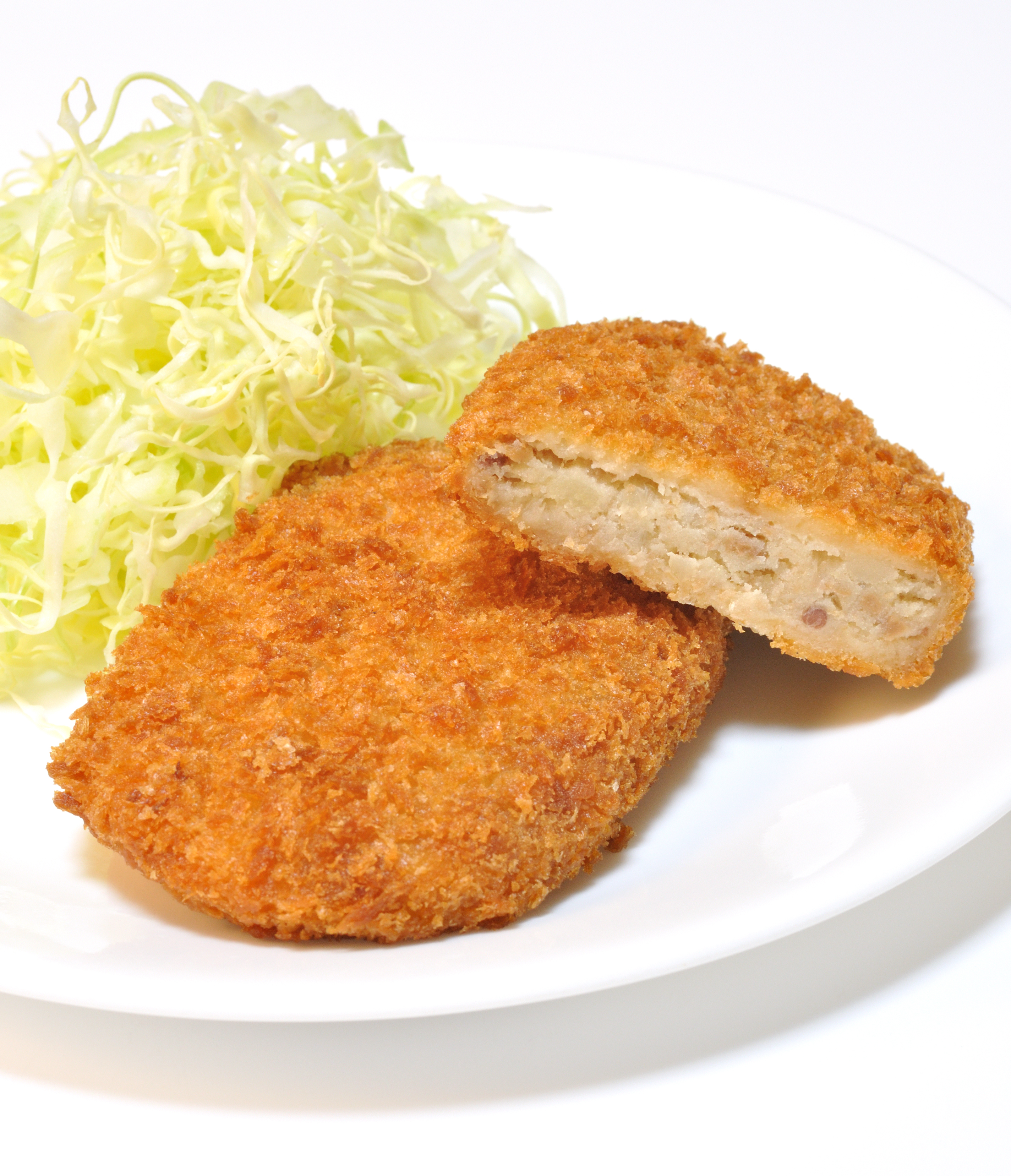|
Patty
A patty or burger (in British English) is a flattened, usually round, Serving size, serving of ground meat and/or legumes, grains, vegetables, or Meat analogue, meat alternatives. Patties are found in multiple cuisines throughout the world. In British and American English, minced meat that is formed into a disc is called a burger, whether it is in a bread roll or not. The word “patty” is also used in American English but almost unknown in British English. The ingredients are compacted and shaped, usually cooked, and served in various ways. Some foods termed "patties" use ingredients inside a pastry crust that is then baked or fried. Some patties are breaded, then baked or fried. In London, since the late 1980s, the Jamaican patty, similar to the Cornish pastie, is a common food item. Etymology The term originated in the 17th century as an English alteration of the French word pâté. According to the OED, it is related to the word pasty, which is various ingredients e ... [...More Info...] [...Related Items...] OR: [Wikipedia] [Google] [Baidu] |
Songjeong Tteok-galbi
''Tteok-galbi'' () or grilled short rib patties is a Korean beef dish made with minced beef short ribs. * Originally a royal dish, ''tteok-galbi'' is now a local specialty of Gyeonggi Province in the central-west region and South Jeolla Province in the south-west region of the Korean Peninsula. Etymology ''Tteok-galbi'' (), literally translated to "cake ribs" as ''tteok'' () means "rice (or other grain) cake" and ''galbi'' () means "rib". The name comes from the food's similarity in appearance to ''tteok''. The process of kneading and shaping the meat is similar to the process of making a rice cake. The final dish is also soft and tender, much like a rice cake in texture. The word ''tteok-galbi'' has a relatively short history that starts in the late 1960s to early 1970s. Before that, the dish was called ''hyo-galbi'' (), meaning "filial piety ribs", or ''no-galbi'' (), meaning "elder ribs", as it was often a dish for older people whose teeth were too weak to bite off meat fr ... [...More Info...] [...Related Items...] OR: [Wikipedia] [Google] [Baidu] |
Main Dish
A main course is the featured or primary dish in a meal consisting of several courses. It usually follows the entrée ("entry") course. Typically, the main course is the meal that is the heaviest, heartiest, and most intricate or substantial on the menu. Typically, meat or fish is the main component; but, in vegetarian meals, the main dish will occasionally make an effort to resemble a meat course. Usage In the United States and Canada (except Quebec Quebec ( ; )According to the Canadian government, ''Québec'' (with the acute accent) is the official name in Canadian French and ''Quebec'' (without the accent) is the province's official name in Canadian English is one of the thirte ...), the main course is traditionally called an "entrée". English-speaking Québécois follow the modern French use of the term entrée to refer to a dish served before the main course. According to linguist Dan Jurafsky, North American usage ("entrée") retains the original French ... [...More Info...] [...Related Items...] OR: [Wikipedia] [Google] [Baidu] |
Ireland
Ireland ( ; ga, Éire ; Ulster-Scots: ) is an island in the North Atlantic Ocean, in north-western Europe. It is separated from Great Britain to its east by the North Channel, the Irish Sea, and St George's Channel. Ireland is the second-largest island of the British Isles, the third-largest in Europe, and the twentieth-largest on Earth. Geopolitically, Ireland is divided between the Republic of Ireland (officially named Ireland), which covers five-sixths of the island, and Northern Ireland, which is part of the United Kingdom. As of 2022, the population of the entire island is just over 7 million, with 5.1 million living in the Republic of Ireland and 1.9 million in Northern Ireland, ranking it the second-most populous island in Europe after Great Britain.The 2022 population of the Republic of Ireland was 5,123,536 and that of Northern Ireland in 2021 was 1,903,100. These are Census data from the official governmental statistics agencies in the respecti ... [...More Info...] [...Related Items...] OR: [Wikipedia] [Google] [Baidu] |
Korean Food Foundation
The Korean Food Promotion Institution ( ko, 한식진흥원) or previously Korean Food Foundation (한식재단) is a nonprofit organization established in March 2010 to enhance the overall well-being of Korean people and the economic status of South Korea by promoting Korean cuisine globally. It aspires to improve competitiveness within the Korean food industries locally and overseas. The organization was established as a public domain with the support of the Ministry of Agriculture, Food and Rural Affairs. The organization has put in efforts to draw publicity and globalize its brand; it has partnerships with several countries to promote Korean cuisine. History In 2009 the Korean Food Foundation Establishment Preparation Committee and Korean Food Globalization Task Force were established. The Korean Food Foundation was established in 2010, with Jeong Wun-cheon selected as its first president. In 2011 Yang Il-sun became the next president and a website with the aim of marke ... [...More Info...] [...Related Items...] OR: [Wikipedia] [Google] [Baidu] |
Pljeskavica
Pljeskavica ( sr-cyr, Пљескавица, ) is a Serbian grilled dish consisting of a spiced meat patty mixture of pork, beef and lamb. It is one of the national dishes of Serbia and is very popular in the neighbouring Balkan and former Yugoslavian countries of Bosnia and Herzegovina, Croatia, and Montenegro. It is a main course served with onions, kajmak (milk cream), ajvar (relish), and urnebes (spicy cheese salad), either on plate with side dishes, or with ''lepinja'' (flatbread, as a type of hamburger). Recently, pljeskavica has gained popularity elsewhere in Europe and is served in a few speciality fast food restaurants in Germany, Sweden, and Austria. Varieties include the "Leskovac pljeskavica" (''Leskovačka pljeskavica''), very spicy with onions; " Šar pljeskavica" (''Šarska pljeskavica''), stuffed with kačkavalj cheese; " Hajduk pljeskavica" (''Hajdučka pljeskavica''), of beef mixed with smoked pork meat; and "Vranje pljeskavica" (''Vranjanska pljeskavica''). ... [...More Info...] [...Related Items...] OR: [Wikipedia] [Google] [Baidu] |
Hamburg Steak
Hamburg steak is a patty of ground beef. Made popular worldwide by migrating Germans, it became a mainstream dish around the start of the 19th century. It is similar to Salisbury steak. It is considered the origin of the ubiquitous hamburger, when, in the early 20th century, vendors began selling the Hamburg steak as a sandwich between bread. History The German equivalent of the Hamburg steak is the '' Frikadelle'', also known as a ''Frikadelle'' or ''Bulette'', which is known to have existed in the 17th century. In the late 19th century, the Hamburg steak became popular on the menus of many restaurants in the port of New York. This kind of fillet was beef ground by hand, lightly salted, often smoked, and usually served raw in a dish along with onions and bread crumbs. The oldest document that refers to the Hamburg steak in English is a Delmonico's Restaurant menu from 1873 that offered customers an 11-cent plate of Hamburg steak that had been developed by American chef Cha ... [...More Info...] [...Related Items...] OR: [Wikipedia] [Google] [Baidu] |
Salisbury Steak
Salisbury steak is a dish originating in the United States and made from a blend of ground beef and other ingredients and usually served with gravy or brown sauce. It is a version of Hamburg steak. Background Hamburg was a common embarkation point for transatlantic voyages during the first half of the 19th century and New York City was the most common destination. Various New York restaurants offered ''Hamburg-style American fillet'', or even ''beefsteak à Hambourgeoise''. Early American preparations of ground beef were therefore made to fit the tastes of European immigrants. Origin of the name James H. Salisbury (1823–1905) was an American physician and chemist known for his advocacy of a meat-centered diet to promote health, and the term ''Salisbury steak'' for a ground beef patty served as the main course has been used in the United States since 1897. Today, Salisbury steak is usually served with a gravy similar in texture to brown sauce, along with various side dishes ... [...More Info...] [...Related Items...] OR: [Wikipedia] [Google] [Baidu] |
Cutlet
Cutlet (derived from French ''côtelette'', ''côte'', "rib") refers to: # a thin slice of meat from the leg or ribs of mutton, veal, pork or chicken # a dish made of such slice, often breaded (also known in various languages as a '' cotoletta'', '' Kotelett'', ''kotlet'' or ''kotleta'') # a croquette or cutlet-shaped patty made of ground meat # a kind of fish cut where the fish is sliced perpendicular to the spine, rather than parallel (as with fillets); often synonymous with steak # a prawn or shrimp with its head and outer shell removed, leaving only the flesh and tail # a mash of vegetables (usually potatoes) fried with bread History Cutlet were a typical starter in French cuisine, as a variation of Croquettes with a shape of small rib (''côtelette'' in French). The bone was simulated by a piece of fried bread or pasta. The recipe became popular in all Europe due to the influence of French cuisine. American and Canadian cuisines From the late 1700s until about 190 ... [...More Info...] [...Related Items...] OR: [Wikipedia] [Google] [Baidu] |
Salisbury Steak (Filete Ruso)
Salisbury steak is a dish originating in the United States and made from a blend of ground beef and other ingredients and usually served with gravy or brown sauce. It is a version of Hamburg steak. Background Hamburg was a common embarkation point for transatlantic voyages during the first half of the 19th century and New York City was the most common destination. Various New York restaurants offered ''Hamburg-style American fillet'', or even ''beefsteak à Hambourgeoise''. Early American preparations of ground beef were therefore made to fit the tastes of European immigrants. Origin of the name James H. Salisbury (1823–1905) was an American physician and chemist known for his advocacy of a meat-centered diet to promote health, and the term ''Salisbury steak'' for a ground beef patty served as the main course has been used in the United States since 1897. Today, Salisbury steak is usually served with a gravy similar in texture to brown sauce, along with various side dishes ... [...More Info...] [...Related Items...] OR: [Wikipedia] [Google] [Baidu] |
Rissole
A rissole (from Latin ''russeolus'', meaning ''reddish'', via French in which "''rissoler''" means "to redden") is a small patty enclosed in pastry, or rolled in breadcrumbs, usually baked or deep fried."Rissole." Accessed June 2011. |
Korokke
Korokke ( ja, コロッケ; ) is the Japanese name for a deep-fried ''yōshoku'' dish originally related to a French dish, the croquette. Korokke is made by mixing cooked chopped meat, seafood, or vegetables with mashed potato or white sauce, usually shaped like a flat patty, rolling it in wheat flour, eggs, and Japanese-style breadcrumbs, then deep-frying this until brown on the outside. History In 1887, the French croquette was introduced to Japan. It is thought that the ''korokke'' using mashed potatoes was invented because dairy processing technology had not been popularized in Japan at that time. The first mention of a "''kuroketto''" appear in cookery books from the Meiji era. ''Korokke'' can be found in almost every supermarket and convenience store in Japan and enjoyed for its taste and its low cost. ''Korokke'' became associated with typhoons in the 2000s, after a user on 2channel said they were eating some to prepare for an approaching typhoon, beginning a tr ... [...More Info...] [...Related Items...] OR: [Wikipedia] [Google] [Baidu] |
Crumlin, Dublin
Crumlin () is a Southside suburb of Dublin, Ireland. Formerly a rural area, it became heavily built up from the early 20th century onwards. Crumlin is the site of Ireland's largest children's hospital, Our Lady's Children's Hospital. Location Crumlin covers the area from the River Poddle near the KCR (Kimmage Cross Roads) to Sundrive Road and Crumlin Cross at ''The Submarine Bar'' to Crumlin's village core and the Drimnagh Road, to Bunting Road, Crumlin Road then along the Grand Canal from Rialto Bridge to Sally's Bridge. It is situated near to the city centre, on the Southside of Dublin city. Neighbouring areas include Walkinstown, Perrystown, Drimnagh, Terenure, and Kimmage. Crumlin is contained within postal district Dublin 12. Name Crumlin gets its name from the "crooked valley" known as Lansdowne Valley. The valley was formed by glacial erosion in the distant past and is now bisected by the River Camac. The valley is situated in front of Drimnagh and is largely mad ... [...More Info...] [...Related Items...] OR: [Wikipedia] [Google] [Baidu] |









